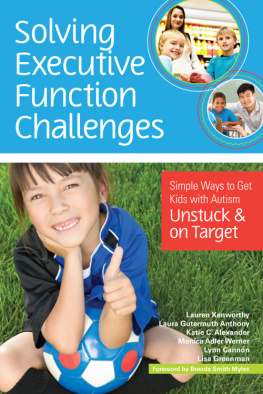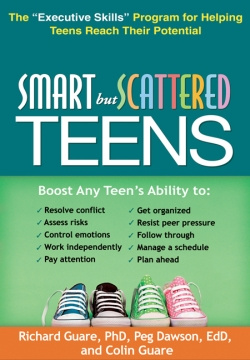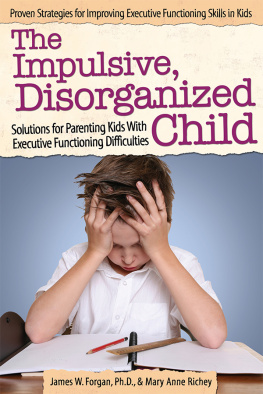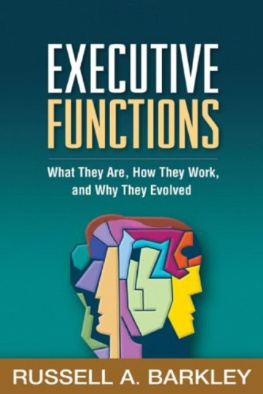
For the first time I have a comprehensive and practical resource to guide my understanding of my sons experience with executive function as a child with autism. Paula Moraines work offers powerful insight and readily applicable concepts to empower all parents, teachers, care givers, and professionals as they embrace someone living with ASD. The books concept of Autistic Access Points has unlocked countless barriers for my child making it possible for him to establish, build, and maintain effective executive skills. Paula Moraines new paradigm gave me the capability to emphasize his strengths and build upon his talents opening infinite possibilities I could not imagine before reading this book.
Michelle Shramek, educator and parent of a child with Autism Spectrum Disorder
The descriptions of thinking from an individual with autism are excellent; I felt like I was talking to my patients. They give the reader a unique insight into the way of thinking of a person with an autistic spectrum disorder, allowing them to dispel any misconceptions they may have. The information in this book is clear, well-organised and offers practical solutions to common problems in the autism population.
Eric Q. Tridas, Director and Developmental Pediatrician, The Tridas Center for Child Development, Florida
by the same author
Helping Students Take Control of Everyday Executive Functions
The Attention Fix
Paula Moraine
ISBN 978 1 84905 884 1
eISBN 978 0 85700 576 2
of related interest
Executive Function Dysfunction Strategies for Educators and Parents
Rebecca A. Moyes, M.Ed.
ISBN 978 1 84905 753 0
eISBN 978 1 78450 045 0
Autism and the Stress Effect
A 4-step lifestyle approach to transform your childs health, happiness, and vitality
Theresa Hamlin
Foreword by John Ratey and Temple Grandin
ISBN 978 1 84905 748 6
eISBN 978 1 78450 178 5
AUTISM
AND
EVERYDAY
EXECUTIVE
FUNCTION
A STRENGTHS-BASED APPROACH
FOR IMPROVING ATTENTION,
MEMORY, ORGANIZATION,
AND FLEXIBILITY
Paula Moraine

Jessica Kingsley Publishers
London and Philadelphia
First published in 2016
by Jessica Kingsley Publishers
73 Collier Street
London N1 9BE, UK
and
400 Market Street, Suite 400
Philadelphia, PA 19106, USA
www.jkp.com
Copyright Paula Moraine 2016
All rights reserved. No part of this publication may be reproduced in any material form (including photocopying or storing it in any medium by electronic means and whether or not transiently or incidentally to some other use of this publication) without the written permission of the copyright owner except in accordance with the provisions of the Copyright, Designs and Patents Act 1988 or under the terms of a licence issued by the Copyright Licensing Agency Ltd, Saffron House, 610 Kirby Street, London EC1N 8TS. Applications for the copyright owners written permission to reproduce any part of this publication should be addressed to the publisher.
Warning: The doing of an unauthorised act in relation to a copyright work may result in both a civil claim for damages and criminal prosecution.
Library of Congress Cataloging in Publication Data
Moraine, Paula.
Autism and everyday executive function / Paula Moraine.
pages cm
Includes bibliographical references and index.
ISBN 978-1-84905-725-7 (alk. paper)
1. Autism spectrum disorders. 2. Cognition. I. Title.
RC553.A88M667 2016
616.85882--dc23
2015025810
British Library Cataloguing in Publication Data
A CIP catalogue record for this book is available from the British Library
ISBN 978 1 84905 725 7
eISBN 978 1 78450 089 4
This book is dedicated to the translators to the parents, teachers, and friends who try valiantly to understand, interpret, and make sense of the autistic experiences in everyday life.
Contents
Preface
This book is born out of a unique and wonderful collaboration between a Finnish autistic savant and myself. Following the publication of my first book, Helping Students Take Control of Everyday Executive Functions The Attention Fix (2012), translations were made into Dutch, Spanish, and Finnish. The Finnish translator, Pia Hmlinen, contacted me, inquiring about accurately translating a specific term in the book from English into Finnish. This simple inquiry led to a sustained and lengthy email exchange on the topic of executive function in relation to autism because the Finnish translator herself is a highly educated, multi-lingual, autistic individual. Her questions were insightful, challenging, and relevant. An electronic friendship ensued, that extended a bit beyond the boundaries of the initial translation work. We began to trust each other with more and more of our individual concerns, and she shared personal experiences of autism that became formative in the writing of this book.
From the beginning of our communication, Pia would point out how students with autism could benefit from the approaches to everyday executive functions that she was translating from my book, indicating how she understood the role of executive functions for the autistic individual. Since her personal experiences were often expressed in fairly explicit theoretical and philosophical concepts, I found myself needing to translate her words into everyday English and into accessible language. Thus, the translated became the translator! Her thoughts were gloriously complex, and while they were clear to her, they were, at times, hard for me to understand. I had to concentrate to understand her, and found that as soon as I did understand, her thoughts were immensely valuable. It started to dawn on me that it did not matter if the thoughts of the autistic person were cloaked in very savant-like complex, theoretical frameworks, or if they were bound up in the autistic childs sensory experiences that could not be articulated; my job was to learn the language of the autistic person well enough to translate for them. So this book really became a book about translation from one language to another, from ones personal experience to another, and about the translation between the autistic and non-autistic worlds.
Pias personal description of her experience as an autistic adult is included in the Appendix at the end of this book. Her characterization of an adults perspective on autism helps articulate how an autistic childs executive function can mature into an adults executive function. Her story also highlights the struggle to first develop, and then integrate, executive skills into everyday life. Her intelligence, clarity, and honesty make her story accessible as well as instructive.
Introduction
Early in our email correspondence, Pia sent this rather provocative statement to me. At first I was taken by surprise that she placed teaching social skills on a slightly lower level of importance than is usual in relation to autism, but it soon became clear to me why she said this:
I think that teaching executive function to people with autism is even more important than teaching social skills. Executive function needs to be learned first, and only then can we get to the social. I think that autism requires a higher degree of executive function organization to be functional than normalcy. The autistic mind is a space, often a chaotic one, that needs to be structured by the use of executive functions.
This statement places high importance on the need to understand the role of executive function in the individual with autism, but this is challenging because the term executive function is not that well known and understood; although it is gaining in popularity and is being used more frequently, it remains a relatively vague term for many. Most of us know maybe one person who has received a diagnosis of executive dysfunction, while we might know several people diagnosed with attention deficit hyperactivity disorder (ADHD), which is automatically considered as executive dysfunction. Autism and ADHD can manifest in the same individual, but as distinct diagnoses. Executive function and ADHD are therefore strongly linked, so any discussion about executive function will naturally include a detailed discussion about attention.
Next page











